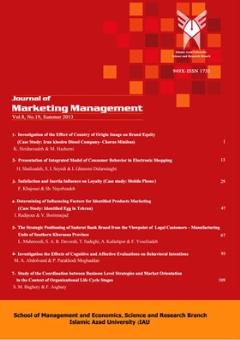interactive marketing model based on the national system of innovation in industrial tools
Subject Areas : Jounal of Marketing Management
Ali Hajiaghabozorgi
1
,
Mahmoud Ahmadi sharif
2
![]() ,
Peyman Ghafari Ashtiani
3
,
Peyman Ghafari Ashtiani
3
![]()
1 - PhD student, Department of Business Administration, Quds City Branch, Islamic Azad University, Tehran, Iran
2 - Assistant Professor, Department of Business Management, Shahr-e-Quds Branch, Islamic Azad University, Tehran, Iran
3 - Associate Professor, Department of Business Management, Arak Branch, Islamic Azad University, Arak, Iran
Keywords: customer attraction, customer loyalty, interactive marketing, national innovation system,
Abstract :
Introduction: Lack of attention to interaction in marketing reduces the understanding of the two-way communication between the company and the customer and leads to the reduction of the company's competitive power. Therefore, the present research aims to design an interactive marketing model based on the national innovation system in industrial tools. The purpose of expanding interaction in marketing is paid. ,
Research method: The current research is of qualitative type. The purpose of research is development. A semi-structured interview has been conducted with twelve experts using the purposeful-judgmental sampling method and in the form of a snowball until the theoretical saturation limit is reached, using the field method.
Findings: Fourteen organized themes and fifty-seven basic themes have been modeled with the theme analysis method, and in this model, three research gaps have been resolved: 1. How to stimulate interaction 2. How to continue customer interaction with the company and 3. How to continue cooperation. The validity of the model has been proven by means of interpretative and theoretical validity. The reliability of the model has been confirmed by Cohen's Kappa coefficient of agreement.
Conclusion: Iran's national innovation system has addressed the relationship between innovative technology and performance. In this research, the proposed model, with the help of innovative technologies, provides an interactive marketing model that improves the company's marketing performance. That is, it has addressed the relationship between innovative technology and performance.
1. Margulis, A., Boeck, H., & Laroche, M. (2020). Connecting with consumers using ubiquitous technology: A new model to forecast consumer reaction. Journal of Business Research, 121, 448-460.
2. Shabani Nejad, Zainab; Nejad Mohammad Namagi, Ahsaneh; Esmailpour, Hassan (2024). The relationship between social media marketing and consumer behavior based on age group with the mediating role of brand value in Irancell communication services company. Marketing Management / Number 16 / Winter: 40-64 DOI: 10.30495/JOMM.2023.70340.1987. [in Persian]
3. Statusbrew (2018). 100 social media statistics you must know [2018] + infographic. https: //blog.statusbrew.com/social-media-statistics-2018-for-business/.
4. Hu, X. (2023). Empowering consumers in interactive marketing: examining the role of perceived control. In The Palgrave Handbook of Interactive Marketing (pp. 117-147). Cham: Springer International Publishing.
5. Siegfried, K. (2019). The role of interactive marketing in IoT-based smart city ecosystems (Master's thesis).
6. Raji, R. A, Mohd Rashid, S, Mohd Ishak, S & Mohamad, B (2020). Do firm-created contents on social media enhance brand equity and consumer response among consumers of automotive brands? Journal of Promotion Management, 26(1)
7. Humphrey, W.F., Laverie, D.A. and Shields, A.B. (2018), “Building the force: enacting fan brand community through the star wars BB-8 droid builders club”, in Wang, C.L. (Ed.), Exploring the Rise of Fandom in Contemporary Consumer Culture, IGI Global Inc., Hershey, PA, pp. 126-146, available at: www.igi-global.com/chapter/building-the-force/190236
8. Wu, Y., Nambisan, S., Xiao, J., & Xie, K. (2022). Consumer resource integration and service innovation in social commerce: the role of social media influencers. Journal of the Academy of Marketing Science, 50(3), 429-459.
9. Opatz, C. P. (2020). From Bean to Bar An assessment of chocolate producing companies advancements towards closing the living income gap of smallholder cocoa farmers (Master's thesis).
10. Yun, J.J.; Zhao, X.; Jung, K.; Yigitcanlar(2020), T. The culture for open innovation dynamics. Sustainability, 12, 5076. [Google Scholar] [CrossRef]
11. Nisar, T.M.; Whitehead, C(2016). Brand interactions and social media: Enhancing user loyalty through social networking sites. Comput. Hum. Behav. 62, 743–753. [Google Scholar] [CrossRef]
12. Hawkins, K.; Vel, P. Attitudinal loyalty, behavioural loyalty and social media: An introspection. Mark. Rev. 2013, 13, 125–141. [Google Scholar] [CrossRef]
13. Naidoo, R., & Potgieter, L. M. (2017). Factors explaining user loyalty in a social media-based brand community. South African Journal of Information Management, 19(1), 1-9.
14. Labrecque, L. I., vor dem Esche, J., Mathwick, C., Novak, T. P., & Hofacker, C. F. (2013). Consumer power: Evolution in the digital age. Journal of Interactive Marketing, 27(4), 257-269. https://doi.org/10.1016/j.intmar.2013.09.002
15. Sajjad, M., & Zaman, U. (2020). Innovative perspective of marketing engagement: Enhancing users’ loyalty in social media through blogging. Journal of Open Innovation: Technology, Market, and Complexity, 6(3), 93.
16. Rezaei, Neda, Eslami, Afshani, & Seyed Alireza. (2023). Contextual exploration of profit-oriented processes through social media marketing. Applied Sociology 34(1), 67-88 [in Persian]
17. Falah Tafti, Hamed, & Dosti Irani. (2022). Fuzzy cognitive mapping of the effect of online interactions on the loyalty levels of tourists (case study: customers of travel agencies on the Instagram social network). Tourism Management Studies 17(58), 133-161 [in Persian]
18. Qu, Y., Cieślik, A., Fang, S., & Qing, Y. (2023). The role of online interaction in user stickiness of social commerce: The shopping value perspective. Digital Business, 3(2), 100061.


